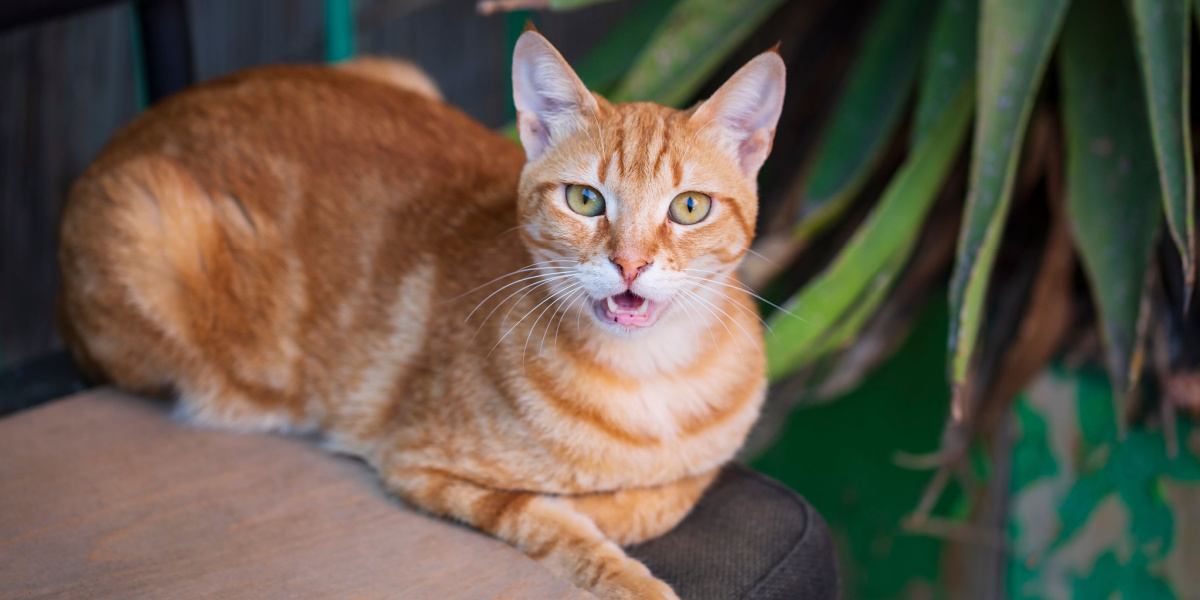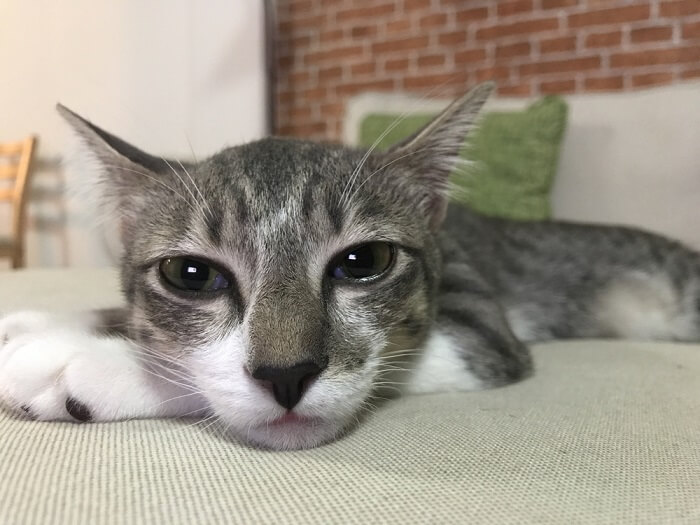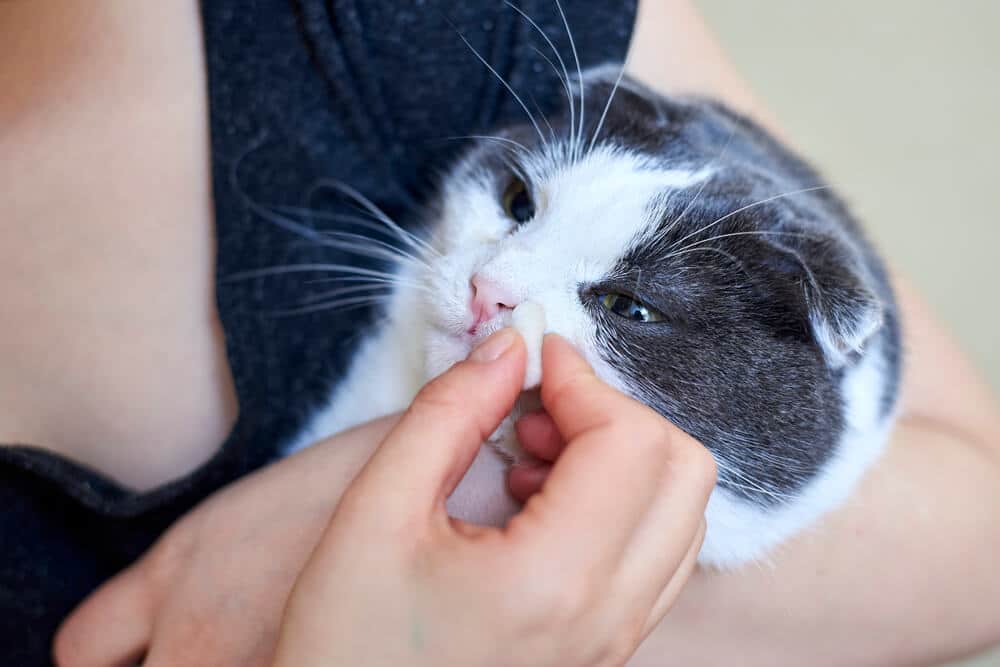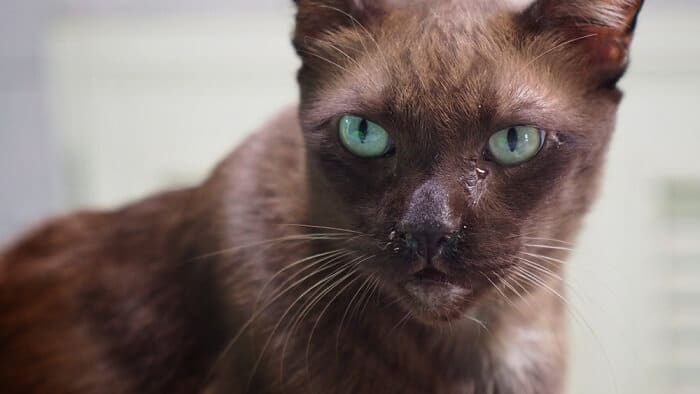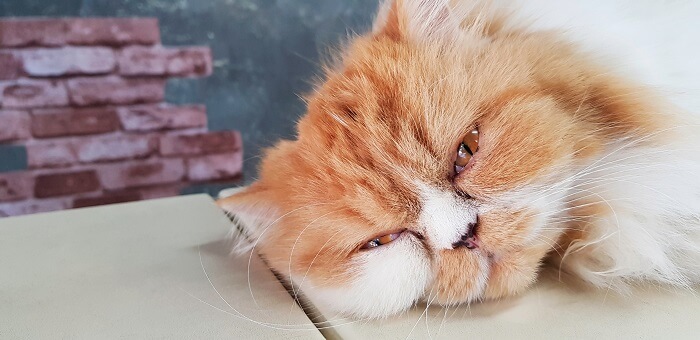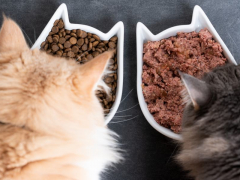Zyrtec is a brand name of antihistamine for the generic drug cetirizine manufactured by Johnson & Johnson. In this article, you’ll learn what Zyrtec for cats is, how it works, when it’s used in veterinary medicine, some common side effects to watch for, and some frequently asked questions.
Zyrtec for Cats Overview

About Zyrtec for Cats
Just like humans, cats will react to allergies with watery eyes and a watery nose.
Zyrtec is an H1 receptor-blocking antihistamine. Histamine is a chemical messenger that triggers responses in the body leading to swelling, redness, and inflammation.
Histamine may be released in response to allergens that come in contact with the body either on the skin or internally. When histamine is released, it leads to the telltale signs of a runny nose and eyes that are associated with allergies. This is a normal reaction that is intended to help flush these foreign invaders from the body.
Interestingly, histamine isn’t only involved with the immune system. It also plays roles in the function of the digestive system (especially the stomach) and acts as a signal transmitter in the brain, spinal cord, and uterus.
An antihistamine is a compound that acts to block histamine release, thus preventing the inflammatory response as well as the drainage and tearing that we all associate with allergies and generally despise.
Also Read: The 5 Best Medication For Cat Allergies
Classes of Antihistamines
There are a couple of classes of antihistamines. First-generation antihistamines include diphenhydramine (Benadryl). This class of antihistamines has the ability to cross the blood-brain barrier and impact histamine’s action as a neurotransmitter, especially as it affects the wake/sleep cycle. This is why Benadryl tends to cause sedation.
Second and third-generation antihistamines do not have this ability and so do not cause drowsiness or sedation at normal doses. They also tend to interact with fewer drugs.
There is also another class of antihistamines called H2 blockers. These act on histamine which functions as part of the digestive tract. These include drugs like famotidine, which suppresses acid production in the stomach.
As an H1-specific 2nd generation antihistamine, Zyrtec only blocks the type of histamine related to allergies and does not typically cause drowsiness.
Also Read: 8 Most Common Cat Sleeping Positions and What They Really Mean
What Does Zyrtec Do for Cats?
While Zyrtec can be beneficial for a cat with allergies, it is important to rule out any other respiratory condition that may look just like allergies.
Just like in people, Zyrtec can have a reasonable impact on allergic responses that lead to a runny nose, sneezing, and watery eyes. It can also help with hypersensitivities or allergic reactions, such as an insect bite or sting.
It’s very important to note here that allergies contributing to these types of signs can be easily confused with mild signs of viral upper respiratory infections. Such a condition may also cause signs of watery eyes, nasal discharge, and sneezing.
Any time a cat has these signs, it’s important to consult with a veterinarian to help determine what the underlying cause may be.
Any nasal or eye discharge with thick, white, or discolored material is very unlikely to be allergy-related. This is more likely an infection that requires a veterinary exam.
Zyrtec’s effect on allergic skin disease, called atopic dermatitis, has mixed results when used for cats. While some clinical trials have shown a reduction in signs of itching, others have shown no significant difference when compared to a placebo. It has also not demonstrated a good efficacy against food allergies in cats.
While using Zyrtec for a cat with itchy skin may not be harmful, there are other medications that may be more effective at addressing an underlying skin allergy.
Also Read: Cat Eyes Watering: Causes, Symptoms, & Treatment
Side Effects of Zyrtec for Cats
Runny eyes and a runny nose are common telltale signs of allergies in cats.
Combination products containing pseudoephedrine as a decongestant (also called the “D” form, like Zyrtec-D) cannot be used in cats (or dogs). This is because pseudoephedrine is toxic to pets.
The oral syrup liquid formulations of Zyrtec may contain propylene glycol, which is toxic to cats and should also not be used.
Regular cetirizine tablets otherwise appear to be well tolerated in cats with few observed side effects. Signs of digestive upset, drooling, and drowsiness may be observed in very high doses.
Zyrtec has very few drug interactions. If your kitty is on a sedative or pain medication, it is possible to see added effects, especially with higher doses of an antihistamine.
Also Read: 15 Human Foods That Are Poisonous & Toxic To Cats
Zyrtec can inhibit a class of drugs called p-glycoprotein substrate drugs. This can include a wide array of drugs from antiarrhythmic to chemotherapy medications. Because cyclosporine (Atopica) is one of them and many cats with skin allergy conditions may be on this medication, it is important to be cautious using cetirizine with it.
Always make sure to ask your veterinarian if you’re not certain if a medication you’re considering for your kitty is safe to use with other medications your cat is already on.
If you are ever concerned that your cat may have developed side effects while using Zyrtec, or if an overdose is suspected, make sure to contact your veterinarian, the ASPCA Animal Poison Control Center (1-888-426-4435), or Pet Poison Helpline (1-855-764-7661) immediately for further advice.
Also Read: Drug Poisoning In Cats: Causes, Symptoms, & Treatment
Zyrtec for Cats Dosage
If your cat’s symptoms do not improve after a couple of doses of Zyrtec, take your cat to the veterinarian for a check-up.
The use of Zyrtec in cats is extra-label, meaning it is not FDA-approved for use in cats. This is very common in veterinary medicine. As such, there are standard accepted doses of Zyrtec for safe use in cats that have been developed.
The general dosage for cats for over-the-counter Zyrtec is 2.5-5mg per cat, given either once or twice a day. This dosage can be tried for either skin itching/allergies or a runny nose and eyes related to allergies.
If you’re giving your cat Zyrtec because your kitty has developed symptoms that appear consistent with allergies but you do not see a good response within 1-2 doses, it’s important to have your cat examined by your veterinarian. This is because Zyrtec may either not be effective enough for your cat’s symptoms or your cat may have a condition (like an infection) that Zyrtec is not effective at treating.
Zyrtec can be given with or without food. If your cat exhibits vomiting after receiving Zyrtec on an empty stomach, try giving the next dose with food or a small treat. If vomiting occurs again when it is given with food, discontinue Zyrtec and contact your veterinarian.
Also Read: Vet Approved Cat Stool Chart: Decoding Your Cat’s Poop
Zyrtec for Cats: Final Thoughts
Excessive lethargy in cats is a symptom of an upper respiratory infection, which needs prompt veterinary assistance to treat.
Zyrtec is very accessible and generally safe to use in cats for allergy-related symptoms. However, its efficacy for such conditions may be variable. Always have your cat seen by your veterinarian if any attempt at using an appropriate over-the-counter medication does not have desired results within 1-2 doses. Liquid formulations of cetirizine and the “D” form (Zyrtec-D) should be always avoided for cats.
Drug Dosing Disclaimer: We are only able to provide doses for medications that are FDA approved for use in cats and only as the label guidelines dictate. For medications that are used off-label we can only provide guidelines and safety information for use. Safe and appropriate dosing for off-label medications can only be determined by a primary care veterinarian.
We encourage you to work with your veterinarian to determine if a particular medication is appropriate for your cat. Changing or adjusting a dose for your cat on your own without consulting with a veterinarian can carry risk. We do not encourage use of medications prescribed for human use in pets without first consulting with a primary care veterinarian.
Frequently Asked Questions
How much Zyrtec can you give a cat?
The dose for over-the-counter Zyrtec (cetirizine) is 2.5-5mg per cat given once to twice a day. This dose is generally safe to use for allergy symptoms related to skin itching and/or runny nose and eyes. However, many other more serious conditions can appear like allergies. If your cat’s symptoms do not improve within 1-2 doses, always make sure to schedule an exam with your veterinarian.
Is Zyrtec safe for cats?
Yes, Zyrtec (cetirizine) is generally safe for cats in the regular over-the-counter tablet form. However, there are two forms that should be avoided in cats. The first is liquid formulations, which may contain propylene glycol which is toxic to cats. The second is the decongestant formulation (Zyrtec-D) which contains pseudoephedrine and is also toxic to cats (and dogs).
Because Zyrtec is a second generation antihistamine, it does not have effects on the central nervous system like diphenhydramine (Benadryl) does and so sedation and drowsiness are uncommonly seen at normal doses. Very high doses or overdoses could still induce drowsiness.
Is Zyrtec good for cat allergies?
There are variable reports on how effective Zyrtec is for cats for either skin allergies or allergies that lead to runny nose, tearing eyes, and sneezing. In some trials, as many as 40% of cats showed improvement in skin itching, while others have shown no benefit over a placebo.
An antihistamine may be more effective in some cats than in others. If no result is seen within 1-2 doses, it’s important to check in with your veterinarian and re-evaluate what may be causing your cat’s symptoms.
Can cats take Zyrtec for sneezing?
Yes, cats can take Zyrtec for sneezing, but only if related to irritants or allergens. It’s important to realize that occasional sneezing in cats can be normal, just like in people. However, more consistent sneezing, especially if accompanied by nasal discharge (even if it’s clear), may not be just allergies.
Cats can commonly have upper respiratory infections caused by viruses, especially feline herpesvirus, which can mimic allergy symptoms. If your cat’s sneezing is also accompanied by white, yellow, or discolored discharge from the eyes or nose, lethargy, or decreased appetite, your cat should be examined by a veterinarian instead of being given Zyrtec.
If a cat has sneezing fits, even if there is no nasal discharge present, this is typically a concerning thing to see and should be evaluated as soon as possible by your veterinarian. This is true even if your kitty appears normal in between those episodes.
